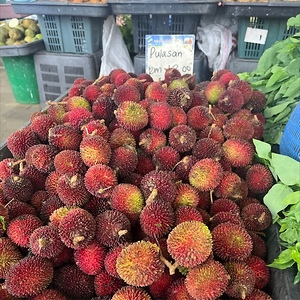


Red Bayberries
Estimated Inventory, ea : 0
Description/Taste
Red Bayberries are small, delicate fruits with a bright red complexion. They are approximately one to two centimeters in diameter and slightly resemble raspberries. These berries have a knobby appearance made up of hundreds of tiny finger-like sections that are similar to the tiny vesicles in citrus fruits. Red Bayberries' shiny, bumpy texture surrounds their juicy, soft, and delicate flesh. Within this flesh is a hard seed about half the size of the fruit. Red Bayberries have a sweet, tart, and succulent taste.
Seasons/Availability
Red Bayberries are available in the summer.
Current Facts
Botanically known as Myrica rubra, Red Bayberries are part of the Myricaceae family. They are commonly called Chinese Bayberry, Waxberry, and Yange Mei, the traditional Chinese name. There are over 50 subspecies of Red Bayberries, all of which grow on large shrubs that can reach up to 10.5 meters in height. These shrubs closely resemble the strawberry tree, Arbutus unedo, an evergreen shrub in the Ericaceae family that produces milder flavored fruits. Beyond their culinary values, Red Bayberries can be made into wax for candles and their dried root bark may be utilized in dyes and tanning agents. Red Bayberries have also been incorporated into charm medicines to exorcize the spirits of the dead.
Nutritional Value
Red Bayberries are a source of vitamins A, C, and E, encouraging healthy vision, immune function, cell growth, reproductive and skin health, collagen production, iron absorption, inflammation reduction, and protection against UV rays and free radical cell damage. This berry contains riboflavin, thiamine, and carotene, helping with energy production and metabolism, cellular function, eye and brain health, nerve and muscle function, and white blood cell production. Red Bayberries provide the body with antioxidants called oligomeric proanthocyanidins that protect against cell and tissue damage, lower blood pressure, regulate cholesterol levels and blood sugar, support blood flow, and improve joint health and antimicrobial properties. In Traditional Chinese Medicine, these fruits were consumed as a tea to stimulate appetite, aid digestion, and dispel cold energy. Native Americans valued Red Bayberry leaves for treating worms and fevers, and used the roots as a poultice.
Applications
Red Bayberries are typically eaten fresh out-of-hand or preserved by canning, drying, or pickling. The berries are frequently used to make jams and jellies. They are incorporated into beverages like juice, smoothies, carbonated drinks, cocktails, wine, and spirits. Red Bayberries may be a topping for salads, flatbreads, acai bowls, yogurt, granola, and cheesecake. They are baked into desserts like pastries, cakes, and tarts. Red Bayberries may be puréed into a sauce for savory dishes like turkey, chicken, and mashed potatoes. Red Bayberries pair well with strawberries, raspberries, loganberries, mulberries, chocolate, mint, salad greens, nuts, and goat cheese. They have a short shelf life, which can reduce their availability and greatly limit the ability to export fresh Red Bayberries.
Ethnic/Cultural Info
Red Bayberry pollen has been traced back thousands of years to a neolithic site in the Zhejiang region where they are from. During the Northern Song Dynasty of Ancient China, they were valued higher than grapes and lychee. In an ancient Chinese legend, the goddess of fruits Mei Zhu was saved from a kidnapping demon by a hunter. She then married this hunter but was shortly pushed off a cliff by a demon. The hunter then buried her beneath a tree, and two years later, it produced fuchsia-colored fruit with a sweet and sour taste that we now know as Red Bayberries. Their sweet and sour flavor profile is meant to evoke memories of her sweet life with the hunter, contrasting with the sour end of her life.
Geography/History
Red Bayberries are native to the Zheijiang Province of China and have been cultivated in this country for centuries. They grow in a variety of climates but are best suited for tropical and subtropical regions. They do particularly well in humidity and high rainfall. This fruit can be found in the wild low mountains of China, in gardens, and in markets throughout their native regions, particularly during the summer. Chinese exports of Red Bayberries have increased exponentially over the last decade. In the southern part of China that's south of the Yangtze River, the economy is dependent on the success of these exports. Red Bayberries are available in the Southern and Eastern United States, Japan, and other areas of Southeast Asia.
Recipe Ideas
Recipes that include Red Bayberries. One
| Healthy World Cuisine |
|
Yang Mei Tart |
| Jasmine Tea & Jiaozi |
|
Yangmei Coulis with Panna Cotta |
| Konkani Cook Book |
|
Bayberry Cheese Cake |








